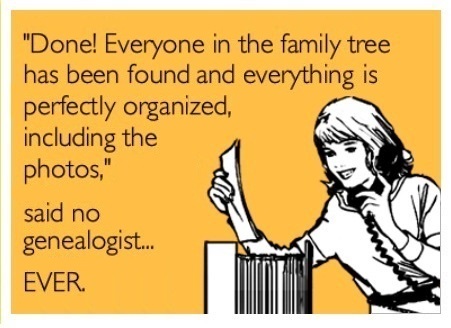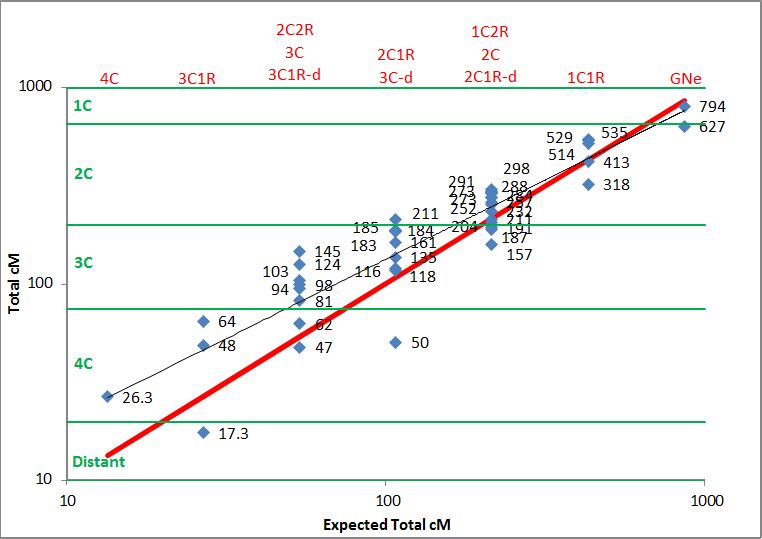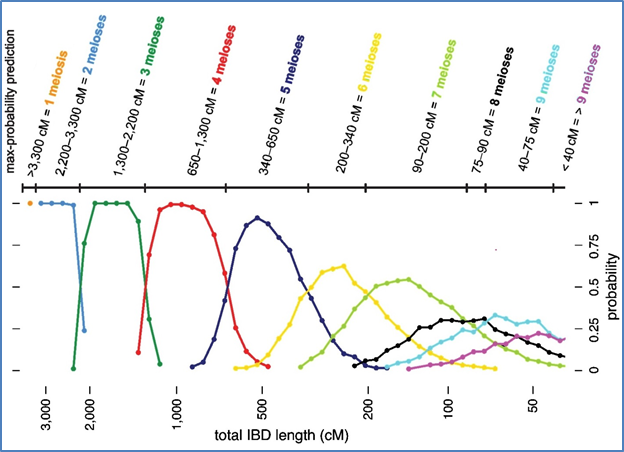|
The
|
||||||||||||||||||||||||||||||||||||||||||||||||
THE BURGENLAND BUNCH NEWS - No. 297 May 31, 2019, © 2019 by The Burgenland Bunch All rights reserved. Permission to copy excerpts granted if credit is provided. Editor: Thomas Steichen (email: tj.steichen@comcast.net) BB Home Page: the-burgenland-bunch.org BB Newsletter Archives: BB Newsletter BB Facebook Page: TheBurgenlandBunchOFFICIAL Our 23rd year. The Burgenland Bunch Newsletter is issued monthly online. The BB was founded in 1997 by Gerald Berghold, who died in August 2008. |
||||||||||||||||||||||||||||||||||||||||||||||||
| Current Status Of The BB: * Members: 2860 * Surname Entries: 8743 * Query Board Entries: 5771 * Staff Members: 15 |
||||||||||||||||||||||||||||||||||||||||||||||||
|
||||||||||||||||||||||||||||||||||||||||||||||||
1) THE PRESIDENT'S CORNER (by Tom Steichen)  This
month's collection of bits and pieces in Article 1, starts us off with a droll quote from a
book, informs you of a new transcription of vital records, points out a couple more edits to our FS Films
section, reports on a massive project that BB Surnames and Villages Editor David Hofer and I undertook over
the last two months, passes along a link to an interesting article about goulash, shares the monthly BB Facebook
report, and terminates with our standard ending bits and pieces (book sales, recipe, cartoon). This
month's collection of bits and pieces in Article 1, starts us off with a droll quote from a
book, informs you of a new transcription of vital records, points out a couple more edits to our FS Films
section, reports on a massive project that BB Surnames and Villages Editor David Hofer and I undertook over
the last two months, passes along a link to an interesting article about goulash, shares the monthly BB Facebook
report, and terminates with our standard ending bits and pieces (book sales, recipe, cartoon).Article 2 is an amended version of a story William O’Driscoll first published in his local newspaper. It tells the tale of a man who he calls The Burg Man of Omsk: Tracking Down a Burgenländer Ancestor in the Austro-Hungarian Army. It is both an interesting story and an excellent source of information about researching WW-I Burgenland soldiers. Thanks, Bill! Article 3 is by Frank Paukowits, who presents for us a new DNA tool that was recently released by MyHeritage called “AutoClusters.” Much as its name indicates, it is a tool for automatic Clustering of Autosomal DNA Matches. Article 4 is a follow-up to an article I published last May about DNA-Based Cousinship Estimation. That article looked at FamilyTreeDNA's ability to accurately predict the relationship level of my known cousins who had tested on their service. This new article does similarly for the AncestryDNA testing service... but it has its own twists! I call it the AncestryDNA Edition of the article. The remaining articles are our standard sections: Historical Newsletter Articles (this month providing the origins of two BB features), and the Ethnic Events and Emigrant Obituaries sections. For all you Grandparents in the BB (yes, I'm one of them): The following quote made me chuckle gently (it is spoken by the narrator of a book about his fictional ex-partner and
wife):
So what caused these discrepancies?
I did enjoy the article, Bob, and I expect our BB members will too, so I'm passing it along. |
||||||||||||||||||||||||||||||||||||||||||||||||
2) THE BURG MAN OF OMSK: TRACKING DOWN A BURGENLÄNDER ANCESTOR IN THE AUSTRO-HUNGARIAN ARMY (by William O’Driscoll) Family stories about my wife’s grandfather, Alois Muhr, were almost legendary. Born in Burg, Burgenland, on the present border between Austria and Hungary, Alois had fought in World War I on the Eastern Front. Alois was captured by the Russians and interned in a Siberian prison camp. While in the prison camp, Alois met a newly married man, Frank Tissinai, from the neighboring village of Dürnbach (Incéd), and they had become good friends. When Frank realized he was dying, Frank made Alois promise to return to Dürnbach and take care of his wife, Elizabeth. After some time in the prison camp, Alois was sent to a Siberian farm to work in place of the farmer, who had been called up by the Russian Army. Alois reportedly worked the farm for several years, and replaced the farmer in every sense of the word. Could there be Muhr relatives somewhere in western Russia? When World War I ended for Russia and the Russian Civil War commenced, Alois spent several years with the Whites, running from the Reds, and only was able to return to his home in Austria years after he left. In the final chapter of the family story, Alois followed Frank’s widow Elizabeth to America and married her in Chicago. “Wow!” I thought, when I heard these stories for the first time. “Can any of this be true?” After much investigation, I have confirmed more than half of it and have disproved none of it. 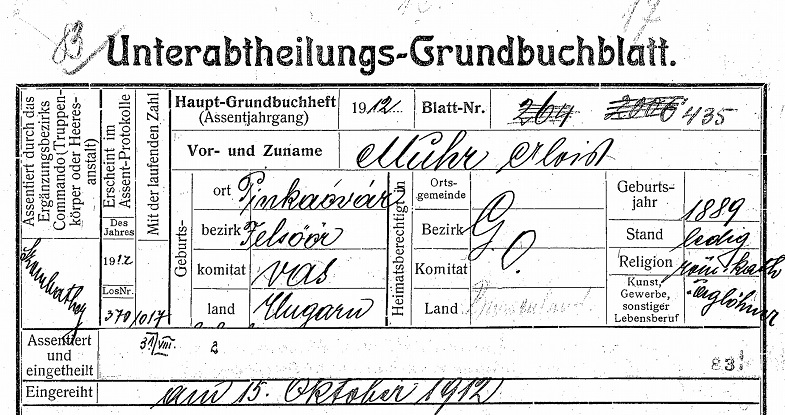 Figure 1 Excerpt from Military Record of Alois Muhr – Name & Description What follows is my reconstructed investigation into these stories. Where to start was my first hurdle. Since Austria-Hungary had a history of military conscription, I decided to start with military records. I knew the date and location of Alois’ birth to be April 21, 1889, in the village of Burg. At the time, Burg lay in western Hungary and was called Pinkaóvár. Burg/Pinkaóvár was located near Felsöór (Oberwart) in the county of Vas, Hungary. I soon learned that much of Austria’s military records were intact and held in the Österreichisches Staatsarchiv Kriegsarchiv (Austrian State Archive, War Archive) in Vienna (the address I used was Kriegsarchiv, Nottendorfergasse 2-4, A-1030 Wien, Austria). But Muhr is a common name, and Alois, the English counterpart of Louis, is also fairly common. Even though there were many professionals in the Archives who I could ask to do the search, I needed to provide more information to avoid a long and potentially fruitless effort. I started trying to determine which military unit Alois would have been in. Most useful was a website (www.austrianphilately.com/dixnut/) on stamp collecting! This website provided a comprehensive explanation of the structure of the Austro-Hungarian Army, breaking that structure into regiments (the proper term is actually “k.u.k. Ergänzungsbezirke” [Imperial and Royal Supplementary/Replacement Districts] but ‘regiment’ makes more sense to me) which recruited in specific geographic areas. This was great! All I had to do was identify the regiment recruiting the village of Burg in the present-day Burgenland area of Austria, and I could probably find Alois’ military records. Unfortunately, it was not as easy to identify the regiment as you would expect. Eventually, I determined that the nearest k.u.k. Ergänzungsbezirke appeared to be that of Regiment 83, whose area of responsibility is Pozsony (Preßburg), W. Hungary. Moreover, Regiment 83 had been associated with that area for an extended period of time preceding World War I. [Editorial note: The 83rd Regiment (Infanterieregiment Schikofsky Nr.83) recruitment was based in Köszeg (Güns) and in Szombathely (Steinamanger) (per BB newsletter 253 #04). Of these, Szombathely was the closer to Burg so more likely its recruiting Battalion. Page www.austro-hungarian-army.co.uk/infantry.htm says the Regiment headquarters was at Komárom (but this data was circa Feb 1914, not 1912). Page www.austro-hungarian-army.co.uk/infdep14.htm, indicates that the 83rd reported through V Corps, so there would have been a “higher-command” Pozsony connection (but not a direct recruitment connection). The reporting structure had the 83rd regiment as part of the 66th Brigade of the 33rd Division of V Corps, 1st Army (Northern Front).  As for
the easiest way to determine the exact recruiting district for a Burgenland village, the 1913 Hungarian Gazetteer
lists the numbers for the Military Supplementary district, the Honvéd brigade, and the Landsturm
district that each town was part of... the appropriate section in the gazetteer entry for Burg (Pinkaóvár) is
highlighted above, and it indicates the 83rd (the 1913 Gazetteer can be accessed from the BB website).] As for
the easiest way to determine the exact recruiting district for a Burgenland village, the 1913 Hungarian Gazetteer
lists the numbers for the Military Supplementary district, the Honvéd brigade, and the Landsturm
district that each town was part of... the appropriate section in the gazetteer entry for Burg (Pinkaóvár) is
highlighted above, and it indicates the 83rd (the 1913 Gazetteer can be accessed from the BB website).]Now I felt confident enough to contact an expert in the Kriegsarchiv in Vienna, Oberrat Dr. Christoph Tepperberg. My alternative would have been to fly to Austria and do the research myself, but paying an archivist about $100 was a lot more economical than a trip to Europe. In short order, Dr. Tepperberg provided me with copies of roughly a ten-page file on Alois Muhr. Alois’ village of Burg was variously called Pinkaóvár and Oberwart [Ed: probably referring to the district Burg is in: Oberwart = Felsöór], and you will see Alois Muhr identified in Figure 1’s excerpt as being born in 1889 and residing in Pinkaóvár. The file, partly shown in Figure 2, confirmed that Alois was conscripted by the Austro-Hungarian Army in 1912, then called up for service at the start of WW-I. 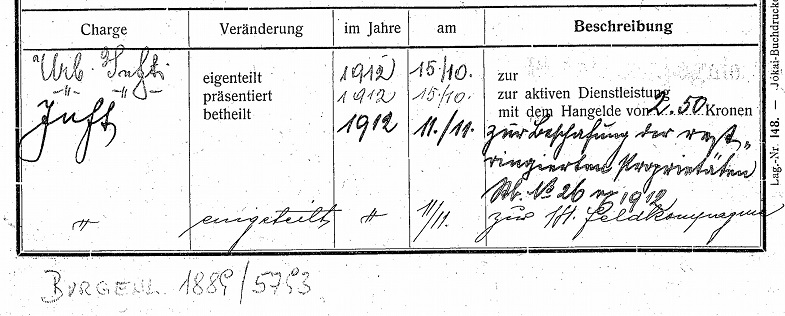 Figure 2. Excerpt from Military Record of Alois Muhr - Conscription As best as I can tell, Regiment 83 was part of the V Korps in the August 1914 structure of the Austro-Hungarian Army (see www.austrianphilately.com/dixnut/dn3.htm, Chapter 3, Appendix A). V Korps was involved in the Battle of Galicia (aka, the Battle of Lemberg) where the Austro-Hungarian and Russian forces faced each other in a series of confrontations in August and September of 1914. Ultimately, the Austro-Hungarian forces were routed with Austro-Hungary losing an estimated total of 324,000 men including Russian forces capturing between 100,000 and 130,000 Austro-Hungarian soldiers. It is very likely that Alois was captured in this first major engagement of the Great War on the Eastern Front and the file seems to say Alois was captured 9 Sep 1914 at the Battle of Biechawa (see Figure 3 below). However, I have, as yet, been unable to identify this Battle other than I am fairly certain it fell within the Battle of Galicia. In any event, the capture of Alois probably was the best thing that could have happened to him since I think his odds of surviving four years of World War One would have been slim.  Figure 3. Excerpt from Military Record of Alois Muhr - Capture [Editorial comment: The text in Figure 3 says only that Alois became a POW on 9/9/2014 “in the fighting near Biechawa.” Bychawa (correct current spelling) was quite near (or even in) the initial battle line for what is recorded as the Battle at Krasnik (which is part of the Galician/Lemberg battles) and took place 23-25 Aug 1914. A map at www.historycentral.com/ww1/Galicia.html shows the full Battle of Galicia. 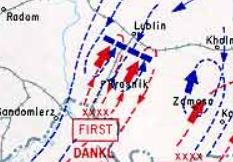 I
show a small clip from the full map here: note the heavy blue dotted line, which was the initial Krasnik battle
line just SW of Lublin (Krasnik is somewhat obscured but visible under the red markings). At the bottom of the clip is text
"FIRST, DANKL" in red. I
show a small clip from the full map here: note the heavy blue dotted line, which was the initial Krasnik battle
line just SW of Lublin (Krasnik is somewhat obscured but visible under the red markings). At the bottom of the clip is text
"FIRST, DANKL" in red.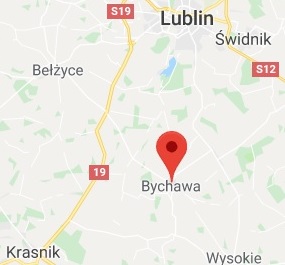 Viktor
Dankl was Commander of the 1st Army, and V Corps and its 33rd Infantry Division (of which Regiment 83 was a part) were in
that battle. Viktor
Dankl was Commander of the 1st Army, and V Corps and its 33rd Infantry Division (of which Regiment 83 was a part) were in
that battle. In a GoogleMaps blow-up of that area, shown to the left, you can see Lublin, Krasnik and Bychawa. As the battle ended August 25 and Alois was captured September 9, it seems apparent that Alois wandered free for a number of days before being gathered in as a POW or that his capture was not reported for a short while.] The file confirmed that Alois remained a prisoner of war until at least 1919. We know this because the Russian government sent an annual postcard to the Austrian government confirming that Alois was a POW in either Omsk or Nikolsk Ussuriysk. [Editorial comment: Actually, the Russians provided lists, which the Red Cross turned into index cards and forwarded to the various governments.] Three of these postcards were part of the file. The 1919 postcard is shown in Figure 4, indicating that Alois was held in Omsk, in the far east of Russia, near Siberia. The other postcards identified Alois’ location as Nikolsk Ussuriysk, a small town north of Vladivostok near both the Pacific Ocean and the Russian border with China. The file, particularly the postcards, essentially confirm more of the family story. 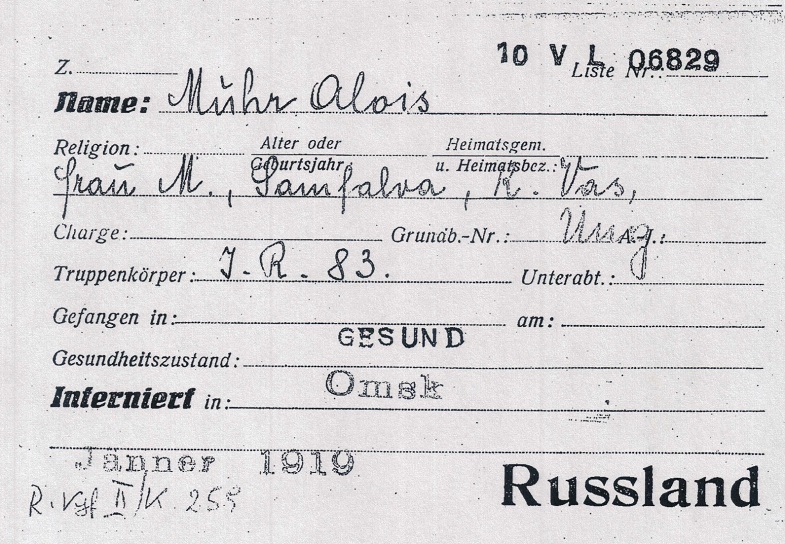 Figure 4: Prisoner of War index card for Alois Muhr Regarding the wife of Frank Tissinai, Elizabeth emigrated to Chicago on the SS Seydlitz, arriving in New York on 18 May 1922. Alois followed on the SS Oropesa, arriving in New York on 31 Oct 1922, and marrying the widow Elizabeth Tissinai on 21 April 1923 in Chicago. Elizabeth’s maiden name was originally Elizabeth Golacz, basically confirming that Elizabeth had a first marriage to Frank Tissinai! In the course of writing this article, I learned that Frank and Elizabeth had married on 9 November 1912 in Dürnbach. Alois’ involvement in the aftermath of the Russian revolution is not as clear. The October Revolution terminated Russia's participation in the World War I, with the Bolsheviks signing the Treaty of Brest-Litovsk with Germany in March 1918. A civil war for control of Russia followed, with the Red Army ultimately winning control of Russia after over-coming opposition from a loosely-allied diversity of interests known as the White Army. The postcard of Figure 4 confirms that Alois was still a prisoner of war in January 1919, some months after the Treaty. Was Alois being moved around by White Russians, was Russia simply slow to repatriate prisoners in the chaos of the Revolution, or was Russia reluctant to give up the free labor of provided by these prisoners? This we may never know. Regarding Alois and his relationship with the farmer’s wife, I am not presently aware of any known records which could confirm or refute this part of the family story, although I am certainly interested in learning of any extant Russian records. Alternatively, perhaps DNA tests may some day turn up a relative in Siberia. So Alois, who journeyed from
Burgenland to Siberia and ultimately to Chicago, lived the rest of his life in Chicago, passing away at the venerable age of
92. His son fought for the United States in World War II, and his grandson still resides in the Chicago area. For the Muhr
family, it is great that most of the family stories about Alois Muhr have been confirmed. |
||||||||||||||||||||||||||||||||||||||||||||||||
3) CLUSTERING OF AUTOSOMAL DNA MATCHES (by Frank Paukowits) There are a number of companies that provide autosomal DNA testing for the public. The major ones include: Ancestry.com, 23andMe, FamilyTreeDNA, Geno 2.0 and MyHeritage. This is the group that is leading the field in the development of new tools to assist people who are researching their family roots. One of the tools that was rolled out by MyHeritage in March 2019 is called “AutoClusters.” Essentially, it analyzes your matches and groups those matches that form clusters, where everyone in the cluster will likely be on the same ancestral line. As an example, it might identify your matches in your grandmother’s paternal line, or your great-grandfather’s maternal line. Having this information might help you identify new familial lines and relationships, especially where family trees are included in your matches’ analyses, or other relationships that have already been established in your own family tree. My wife, brother and I had all been tested at FamilyTreeDNA, but we uploaded our results to MyHeritage to see how this new tool worked. There was no cost to do this since I maintain an account with MyHeritage. The results were tabulated two ways: 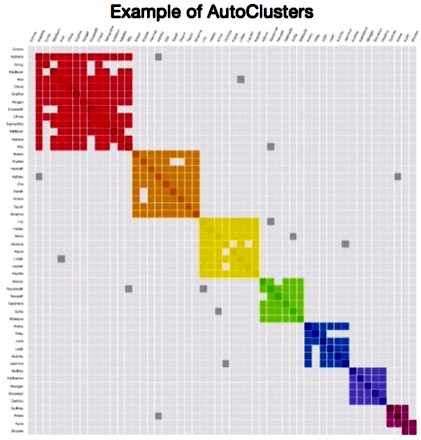 in a
visual/graphic presentation, and a more-traditional line-by-line format. To the right is an example (dummy) graph, taken
from the MyHeritage website, where each color group represents a cluster. in a
visual/graphic presentation, and a more-traditional line-by-line format. To the right is an example (dummy) graph, taken
from the MyHeritage website, where each color group represents a cluster.MyHeritage has established minimum criteria as the cutoffs for inclusion in a cluster: matching of at least 20cM in the aggregate between the person tested (for example, me) and one of my DNA matches, and at least 15 cM between everyone else in the same cluster. The 15cM cutoff eliminates fifth and greater cousins and helps reduce the time needed to calculate the clustering. There is also a maximum cutoff: 360 cM, used to eliminate people closer than second cousins to the person tested, as such people would logically belong to many of my clusters and could not be placed in just one cluster (even with this max cutoff, some closer cousins may still belong to a couple of clusters, so they are shown in darker gray squares... see the example graph). The percentage of total matches that were identified as part of a cluster were 4.8% (75 of 1,576) for my wife, 4.5% (105 of 2,329) for my brother, and 3.2% (71 of 2,204) for me. The average cluster size was between 3 and 4 people. At first blush, those would seem to be relatively small numbers but, considering that it could lead to establishing familial lines that you never knew existed, it still is an important tool for effectively targeting your research efforts, especially where substantive family trees are available. My recommendation would be for people to look at incorporating DNA clustering into their research toolkit, especially when they have already been tested by MyHeritage (as there would be no additional cost). For those tested by another vendor, you might want to consider uploading your data anyway (it is only a $35 fee). Doing so will give you a larger collection of people to match with (I could identify less than 1% of my 2,200 MyHeritage matches as being people matching me at FamilyTreeDNA)... and, if you also use the auto-clustering tool, you may gain new knowledge! |
||||||||||||||||||||||||||||||||||||||||||||||||
4) DNA-BASED COUSINSHIP ESTIMATION - ANCESTRYDNA EDITION A year ago, I wrote an article with title DNA-Based Cousinship Estimation that discussed my observations about the ability of FamilyTreeDNA autosomal tests to accurately detect the cousinship level for a predicted DNA cousin; for example, is a predicted third cousin a true third cousin? In this question, predicted means the level of cousinship indicated by the DNA test and true being the cousinship level shown by a well-documented family tree (which I have for my lines). My investigation was driven by my reading of various reviews of the autosomal tests from the "big three" testing companies, AncestryDNA, 23andMe, and FamilyTreeDNA. What I observed was that a common "complaint" about FamilyTreeDNA was that its test over-estimates the nearness of a family relationship... for example, a true third-cousin may be predicted as a second cousin. At the time, I had 14 relationships on FamilyTreeDNA that I could use to "test" whether this complaint was true (that is, I could document the true relationship for a predicted cousin). What I reported was that, among the 14 relationships: -- 4 predictions were accurate, matching the true relationship -- 2 predictions under-predicted (true relationship closer than predicted) -- 8 predictions over-predicted (true relationship more distant than predicted) Thus I concluded, by a simple count, that FamilyTreeDNA tended to over-estimate the nearness of a family relationship, just as the critics claimed. The rest of the article, however, examined more deeply why this over-prediction occurred, with much of the reason explained by the graph below: 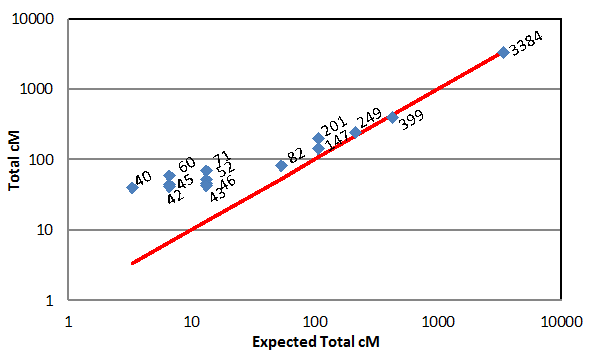 The data points in the graph are my 14 relationships, with
the measured amount of common DNA (between me and the cousin) along the vertical axis (titled Total cM)
and the amount expected for each true relationship along the horizontal axis (titled Expected Total cM).
For each prediction to be totally accurate, each data point would need be on the red line (the "one-to-one" line, where
Total cM = Expected Total cM). At some point, when AncestryDNA offered their test on-sale, I decided to have my DNA analyzed by them too.
While I no longer recall any "complaints" about the accuracy of their predictions, I do recall many
complaints about the limited information AncestryDNA shares, especially the lack of a "chromosome browser" and
details on which segments of DNA are shared with a specific cousin. These, to me, are valid complaints and limit the value
of the AncestryDNA test.
Based on this table, here is how my 42 relationships scored:
|
||||||||||||||||||||||||||||||||||||||||||||||||
5) HISTORICAL BB NEWSLETTER ARTICLES Editor: This is part of our series designed to recycle interesting articles from the BB Newsletters of 10 years ago. For this month, I pulled a piece from May 2009 that tells us about the Hianzn Museum in Rábafüzes, Hungary. You may recall two articles a few months back that discussed the Hianzn and the Hianzisch dialect. This seemed an appropriate "follow-up" (even though it originated 10 years ago!). THE BURGENLAND BUNCH NEWS - No. 187 May 31, 2009 HIANZNMUSEUM IN RAABFIDISCH / RÁBAFÜZES "Do not forget that tomorrow, today's tool is already history." / Franz Dankovics In Burgenland today there are several ethnic groups, among them Croatian and Hungarian. But German-speaking Hianzn still live behind the Hungarian border. A museum in Rábafüzes tells their story. The first Hianznmuseum in Raabfidisch (Rábafüzes) was opened in Hungary. The village (of approximately 400 inhabitants) is today a part of the town Szentgotthárd. There are still about 50 people who speak "Hianzisch". A museum was devoted to them and their forefathers in what was formerly the village school. Memorial to the farmer culture and the Hianzn The ethnological collection's foundation stone was laid by the former principal Ferenc Dankovics and his wife in the sixties. On 26th May 1986 the collection was opened to the public in the school building. After Ferenc Dankovics' death, the collection was also extended and, after years of hardship, it came under the maintenance of the Local Government of the German Minority and the Branch Library in Rábafüzes. The present exhibition room was provided by the local government as a final place and, after being redesigned, opened its gates to the public. In the meantime, 500 exhibits have been assembled with years of hard work. The whole inventory is labeled in Hungarian, German, and Hianzisch. Contacts in Burgenland Until World War II, the population of Rábafüzes had close contact with their neighbors in Burgenland. The place was pulsing, says the village eldest, 86-year-old Paula Nagy Vincené. "There were 5 guesthouses in our village, 3 were outside in Bergen. Then there was another guest house next to the border that already belonged to Burgenland - we also went there to dance", says the 86-year-old. Female Choir of Rábafüzes In 1976 the Female Choir in Rábafüzes was formed, which has faithfully maintained the song lore of the village and the surrounding areas ever since then. The songs are also presented in vernacular "Hianzisch". The founder and leader of the choir is Magdolna Unger, and its harmonica accompanist is her sister, Edit Unger. The choir has 2 albums so far. Hianznmuseum, Rábafüzes/Raabfidisch, Kodály Zoltán út 2 Open hours: Wednesday: 11 am - 4 pm; Friday: 12 noon - 6 pm |
||||||||||||||||||||||||||||||||||||||||||||||||
6) ETHNIC EVENTS LEHIGH VALLEY, PA Friday–Saturday, June 7-8: Sommerfest at the Lancaster Liederkranz. Entertainment by Maria & John, Die Alpenländer, The Bratwurst Boys, folk dancers and singers. Info: www.lancasterliederkranz.com Sunday, June 16: Edelweiss Schuhplattlers Fundraiser Clambake at the Reading Liederkranz. Music by Maria & John. Info: www.readingliederkranz.com Sunday, June 23: 102nd Stiftungsfest at the Coplay Sängerbund. Entertainment by The Emil Schanta Band and Austrian/German choral groups. Info: www.coplaysaengerbund.com Sunday, June 23: Parish Festival at Queenship of Mary Catholic Church (formerly Our Lady of Hungary) in Northampton. Music by MountainXpress. Info: queenshipofmary.weconnect.com Saturday, June 29: Wurstfest at the Reading Liederkranz. Music by Mountain Xpress. Info: www.readingliederkranz.com NEW BRITAIN, CT Friday, Jun 1, 7 pm: Heimat Abend. Austrian Donau Club, 545 Arch Street, $3. Music by Frank Billowitz. Friday, June 15, 7:30 pm: Heurigan Abend. Austrian Donau Club, 545 Arch Street, $3. Music by Schachtelgebirger Musikanten. |
||||||||||||||||||||||||||||||||||||||||||||||||
7) BURGENLAND EMIGRANT OBITUARIES Maria Habetler (née Rajkovac)  Maria Habetler, 88, of Northampton, Pennsylvania, passed away peacefully on Wednesday, May 15, 2019 in Cedarbrook Nursing Home. She was the wife of the late Ignac Habetler. Born June 4, 1930 in Horvátlövo (Hrvatske Šice/Kroatisch Schützen), Vas Megye, Hungary, she was the daughter of the late Simon and Etelka (Cseri) Rajkovac. Maria worked as a seamstress for many years. She enjoyed cooking and baking for her family. She was a member of the former St Michael’s Catholic Church in Northampton. Survivors: sons, John Habetler, Mr. & Mrs. Steve Habetler; grandchildren, Tracy, wife of Simon Dragovits, Steve Habetler and his wife Rachel; great grandchildren, Courtney, Autumn, Kendall; sisters, Stella Pock and Goldie Skrapits. Maria was predeceased by 6 siblings. Services: A Prayer Service will be held on Tuesday, May 21st at 11:00 a.m. in the Reichel Funeral Home, 326 E. 21st St., Northampton. Family and friends may call 10 -11:00 a.m. Burial will follow in Our Lady of Hungary Cemetery. Online condolences may be submitted at www.reichelfuneralhome.com. Published in Morning Call on May 17, 2019 John I. Unger  John I. Unger, 98, resident at Tuscan Garden, Palm Coast, Florida, passed peacefully on May 9, 2019. Born on June 23, 1920 in Deutsch Schützen, Austria, he was a son of the late Johann and Anna (Standor) Unger. He arrivied in the US in 1931. He enlisted in the US Navy in 1939, graduating both Navy and Marine Corps boot camps, and was assigned a Corpsman with 1st Defense Battalion, US Marine Corps. This unit was assigned the defense of Wake Island that was attacked by the Japanese starting on December 8, 1941 and finally surrendering on December 23rd. John was a Prisoner of War for 44 months in camps in China, Japan and Korea providing aid and comfort to other POW's. Released at the end of WWII, he returned home and continued to serve 20 years, retiring a Navy Chief. John and Alice fell in love in 1939 and enjoyed 74 years filled with joyous times among family and friends in the San Francisco Bay Area. They "started it all" and are survived by sons, John W Unger and Brian L (Jacki) Unger, grand-children Johnny (Stephanie), Tim (Diane), Julie (Alan), Brian P (Kendra), Rachel (Jamil), and Alison (Antonio) as well as coast-to-coast great-grand-children including Michelle (Kyle), Erin, Allyson, Tyler, Jack, Julia, Molly, Timothy, Maddie, Giuliana, Hayden, Jackson and Hayes. He is predeceased and joins Alice and so many that he touched in a life well lived that is shared in the book "The Last Corpsman" written by Juan Carlos Marcos. Family and friends may visit on Monday, May 13, from 10:00-11:00AM at the chapel of Craig-Flagler Palms Funeral Home, 511 Old Kings Road South, Flagler Beach. A celebration of his life will begin at 11:00AM. He will be laid to rest at Queen of Heaven Cemetery in California where he will receive his military honors. In lieu of flowers, kindly consider Veterans of Foreign Wars in his memory. For online condolences go to: www.craigflaglerpalms.com. Arrangements are in the care and trust of Craig-Flagler Palms Funeral Home. Published in Daytona Beach News-Journal from May 11 to May 12, 2019 Agnes Badar (née Magyar)  Agnes Julianna Badar, 82, of South Bend, Indiana passed away on Saturday, April 27, 2019. Born on January 17, 1937, in Ólmod (Plajgor/Bleigraben), Hungary, she was a daughter of the late Thomas and Julianna (Poropatich) Magyar. On July 23, 1960, in Our Lady of Hungary Catholic Church, South Bend, Indiana, she married Victor Badar, who preceded her in death on August 14, 2011. Agnes is survived by two daughters, Mary Shuler of Plymouth, MI and Monica (John) Hehl of Plainfield, IL; one son, Anthony Badar of South Bend, IN; two grandchildren, Matthew Hehl and Victoria Badar; two sisters, Anna Hedl of South Bend, IN and Frieda Botelho of Novi, MI; two brothers, Anthony (Donna) Magyar and Steve (Connie) Magyar, both of South Bend, IN; and by many nieces and nephews. She was preceded in death by two infant sons, Joseph and Victor, Jr. Agnes was a “mom to many” working in the dining hall at St. Mary's College for 37 years. Agnes enjoyed baking, gardening, and was very devoted to her church. Her family was her greatest joy in life. Visitation will be held on Wednesday, May 1, 2019 from 3:00 until 8:00 p.m. at the Kaniewski Funeral Home, 3545 N. Bendix Dr., where a parish Rosary will be prayed at 4:00 p.m. A Mass of Christian Burial will be celebrated on Thursday, May 2, 2019 at 12 Noon in Corpus Christi Catholic Church. Burial will follow in Highland Cemetery. Memorial contributions may be made in Agnes' honor to the American Cancer Society or the Juvenile Diabetes Research Foundation. Online condolences may be left at www.kaniewski.com. Published in South Bend Tribune on Apr. 30, 2019 |
||||||||||||||||||||||||||||||||||||||||||||||||
| END OF NEWSLETTER (Even good things must end!) |
||||||||||||||||||||||||||||||||||||||||||||||||
|
Burgenland Bunch Newsletter, copyright © 2019 by The Burgenland Bunch |
 News
News 4,644
Catholic death records for the Sankt Nikolaus (Szent Miklós) parish for the 1828 to 1895 period. Margaret
previously contributed a similar transcriptions for the Sankt Michael (Pusta Szent Mihály) parish.
4,644
Catholic death records for the Sankt Nikolaus (Szent Miklós) parish for the 1828 to 1895 period. Margaret
previously contributed a similar transcriptions for the Sankt Michael (Pusta Szent Mihály) parish. Correction
(again): Our "FamilySearch (LDS) Microfilms and Digital Collections" section continues to be refined as we
find needed additions or edits... and this is the third month in a row that I have a correction to report...
Correction
(again): Our "FamilySearch (LDS) Microfilms and Digital Collections" section continues to be refined as we
find needed additions or edits... and this is the third month in a row that I have a correction to report... 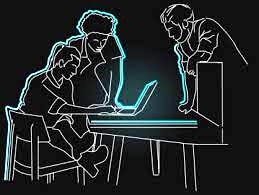 Members,
Surnames and Villages Re-Synced: BB Surnames and Villages Editor, David Hofer, prompted a recent project to get all
of our member-related pages back into sync. What that means is that any member mentioned on one of these pages is referred
to similarly on each of the other pages, as appropriate, and all email-address errors are fixed.
Members,
Surnames and Villages Re-Synced: BB Surnames and Villages Editor, David Hofer, prompted a recent project to get all
of our member-related pages back into sync. What that means is that any member mentioned on one of these pages is referred
to similarly on each of the other pages, as appropriate, and all email-address errors are fixed.  Goulash Recipe:
Member Bob Chapman sent a short message to me pointing out a nice article about goulash, be it the traditional
Hungarian soup studded with meat that was favored by the Hungarian herdsmen that gave it its name (gulyás =
herdsman) or the spicy meat stew known in its homeland as pörkölt or paprikás (depending on the use of
sour cream).
Goulash Recipe:
Member Bob Chapman sent a short message to me pointing out a nice article about goulash, be it the traditional
Hungarian soup studded with meat that was favored by the Hungarian herdsmen that gave it its name (gulyás =
herdsman) or the spicy meat stew known in its homeland as pörkölt or paprikás (depending on the use of
sour cream). 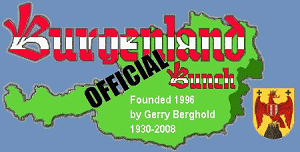 The
Facebook Bunch (from Vanessa Sandhu):
The
Facebook Bunch (from Vanessa Sandhu):  Update
for book "The Burgenländer Emigration to America": Here is this month's update on purchases of the English issue of
the 3rd edition of Dr. Walter Dujmovits' book "Die Amerika-Wanderung Der Burgenländer."
Update
for book "The Burgenländer Emigration to America": Here is this month's update on purchases of the English issue of
the 3rd edition of Dr. Walter Dujmovits' book "Die Amerika-Wanderung Der Burgenländer." This
month's recipe is again from Allentown's St. Peter's Evangelical Lutheran Church, provided by Louise Fielding. I
always wondered what these were called, and if I would ever find a recipe for them. They look like small dumplings, and
Bende sells a product called Tarhonya Egg Drop Noodles, which look very similar to what I remember. My
grandmother used to make these as one of two noodle options for chicken soup at Sunday dinner. The other option, of course,
were the really thin, long noodles; my grandmother would make the dough, but my grandfather took great pride in how thin he
could cut them, so he reserved that job for himself. A true chef!
This
month's recipe is again from Allentown's St. Peter's Evangelical Lutheran Church, provided by Louise Fielding. I
always wondered what these were called, and if I would ever find a recipe for them. They look like small dumplings, and
Bende sells a product called Tarhonya Egg Drop Noodles, which look very similar to what I remember. My
grandmother used to make these as one of two noodle options for chicken soup at Sunday dinner. The other option, of course,
were the really thin, long noodles; my grandmother would make the dough, but my grandfather took great pride in how thin he
could cut them, so he reserved that job for himself. A true chef! 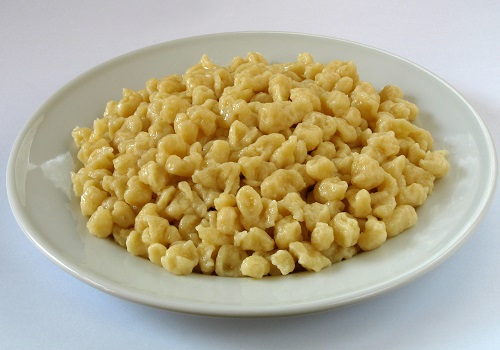
 Add to
chicken or beef broth for a filling soup.
Add to
chicken or beef broth for a filling soup.
